Picture this: You’re framing a second-story addition, and your table saw is three stories below in the truck. You need one crosscut. Just one. Do you haul a 70-pound corded saw up two flights of stairs, string 100 feet of extension cord, and deal with the inevitable trip hazard? Or do you grab your cordless table saw, make the cut in 30 seconds, and move on with your life?
This exact scenario convinced me to test the DeWalt FlexVolt 60V table saw (DCS7485) for six months across multiple job sites. As someone who’s been skeptical of battery-powered “professional” tools for years, I approached this saw with one burning question: Can a cordless table saw actually replace a corded jobsite saw, or is it just expensive convenience that compromises on power?
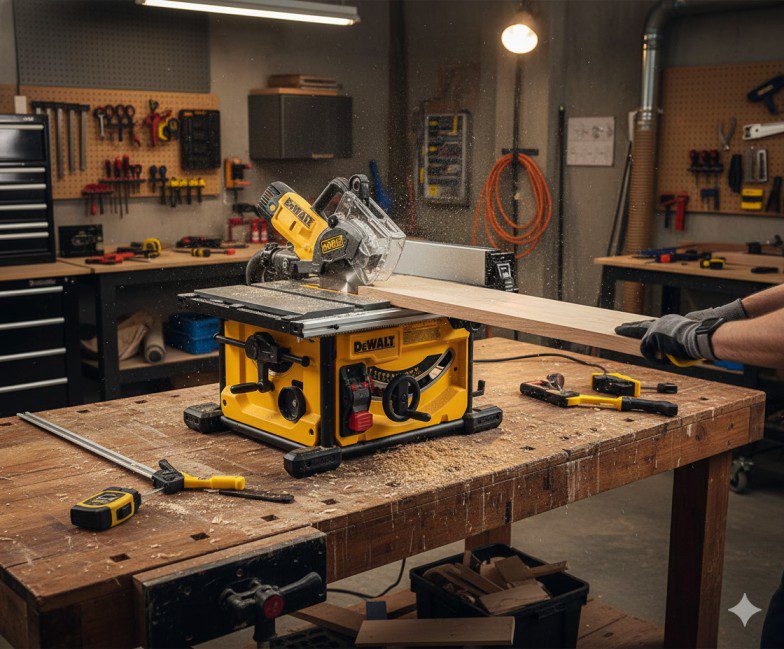
After ripping over 800 linear feet of lumber, breaking down dozens of plywood sheets, and draining more FlexVolt batteries than I care to admit, here’s everything you need to know before spending $549 (bare tool) or $699 (with battery and charger) on DeWalt’s cordless gamble.
Table of Contents
- What Makes the FlexVolt System Different?
- Unboxing and First Impressions
- Real-World Performance Testing
- Battery Runtime: The Numbers That Actually Matter
- Cut Quality and Power Delivery
- Fence System and Accuracy
- Portability Analysis: Weight vs. Convenience
- Comparing Cordless vs. Corded (DCS7485 vs. DWE7485)
- What Works Exceptionally Well
- The Frustrating Limitations
- Who Should Buy This Saw
- Frequently Asked Questions
What Makes the FlexVolt System Different?

Before diving into the table saw itself, understanding DeWalt’s FlexVolt battery technology explains why this saw exists—and why it costs significantly more than corded alternatives.
FlexVolt Technology Explained
FlexVolt batteries automatically adjust voltage depending on the tool: 60V for high-demand tools, and 20V for standard DeWalt tools with extended runtime. This isn’t marketing hype—it’s genuinely innovative battery engineering that solves the power-versus-runtime equation that’s plagued cordless professional tools for decades.
How It Works in Practice:
- Slide a FlexVolt 60V 6Ah battery into the DCS7485 table saw → delivers 60V with 2Ah capacity
- Use the same battery in a DeWalt 20V drill → automatically switches to 20V with 6Ah capacity
- Result: One battery ecosystem for your entire tool collection
Why This Matters for Table Saws: Traditional 20V batteries don’t have enough sustained power for table saw motors. You’d need to stack multiple batteries (like Milwaukee’s approach) or accept severely limited performance. FlexVolt delivers legitimate corded-equivalent power from a single battery.
For woodworkers already invested in DeWalt’s 20V ecosystem, FlexVolt batteries extend runtime on your existing tools while unlocking high-power cordless options. If you’re starting fresh, this means buying into a premium battery platform with upfront costs but long-term versatility.
Unboxing and First Impressions
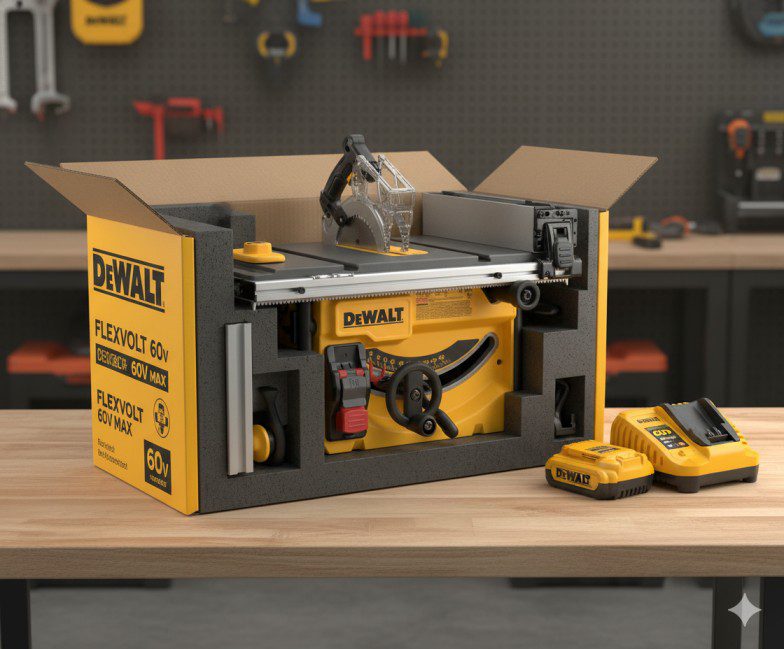
The DCS7485 arrives as either bare tool (DCS7485B) or kit (DCS7485T1 with one 6Ah battery and charger). I tested the kit version across six months of professional use.
What’s Included
DCS7485T1 Kit Contents:
- DCS7485 table saw with roll cage base
- 8-1/4″ 24-tooth carbide blade
- Rack-and-pinion fence system
- Riving knife and blade guard assembly
- Miter gauge (plastic construction)
- Push stick
- Two blade wrenches
- One 60V FlexVolt 6Ah battery
- Fast charger (charges 6Ah battery in ~60 minutes)
Notable Absence: No stand included. You’ll need to budget an extra $100-150 for the DW7451 scissor stand or build your own cart/station. For a $699 kit, this feels like a missed opportunity—every contractor who buys this saw needs something to set it on.
Build Quality First Look
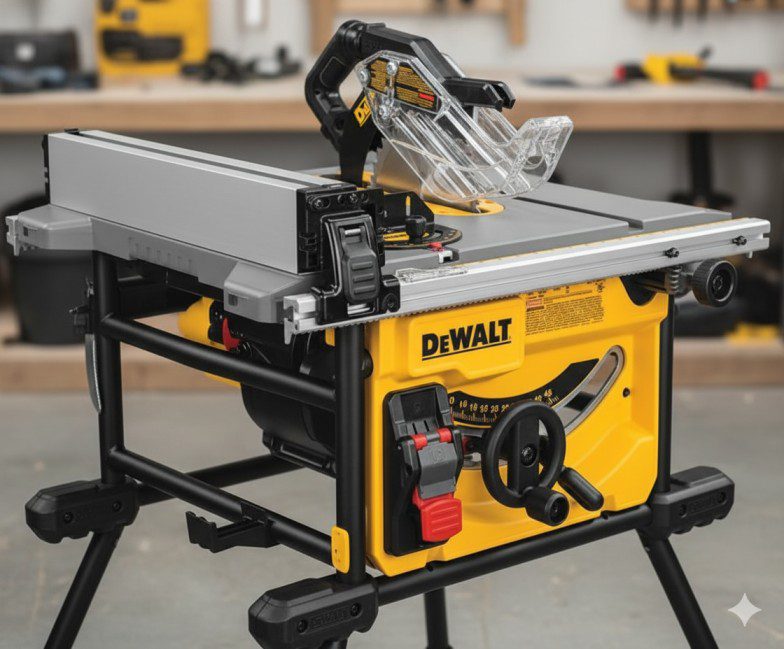
Picking up the DCS7485 immediately reveals DeWalt’s design priorities: At approximately 48 pounds and 13 inches tall with a roughly 23-inch square footprint, it achieves an impressive power-to-weight and size ratio.
Construction Breakdown:
- Table Surface: Cast aluminum with friction-reducing coating (not cast iron)
- Roll Cage Base: Steel tubing (much more durable than plastic jobsite saw bases)
- Fence Rails: Machined aluminum with rack-and-pinion mechanism
- Handle: Integrated molded handle for one-handed carry
Initial Durability Concerns: The aluminum table trades mass and thermal stability for weight savings. For a portable saw, this is the right call—but woodworkers accustomed to cast iron tables will notice the difference immediately. More on this in the performance section.
Real-World Performance Testing
Theory and spec sheets mean nothing if the saw can’t handle actual job site demands. I put the DCS7485 through three distinct testing scenarios to evaluate real-world capability.
Test 1: Framing Lumber Marathon
Scenario: Ripping 50 pieces of 2×10 Doug fir to 7-1/4″ width (8-foot lengths)
Battery: Single 9Ah FlexVolt (purchased separately—highly recommended upgrade)
Results:
- Completed 43 rips before battery depletion
- Consistent cutting speed throughout (no noticeable power drop until final 5 cuts)
- Zero blade bog-downs despite aggressive feed rate
- Battery temperature: Warm but not concerning
Real-World Translation: With a 9Ah battery, expect 12-14 rips through 2x lumber making 8-foot cuts with a few seconds between cuts. That’s enough for most framing tasks between battery swaps. For deck framing or stud wall construction, you’ll want 2-3 batteries in rotation.
Test 2: Plywood Sheet Breakdown
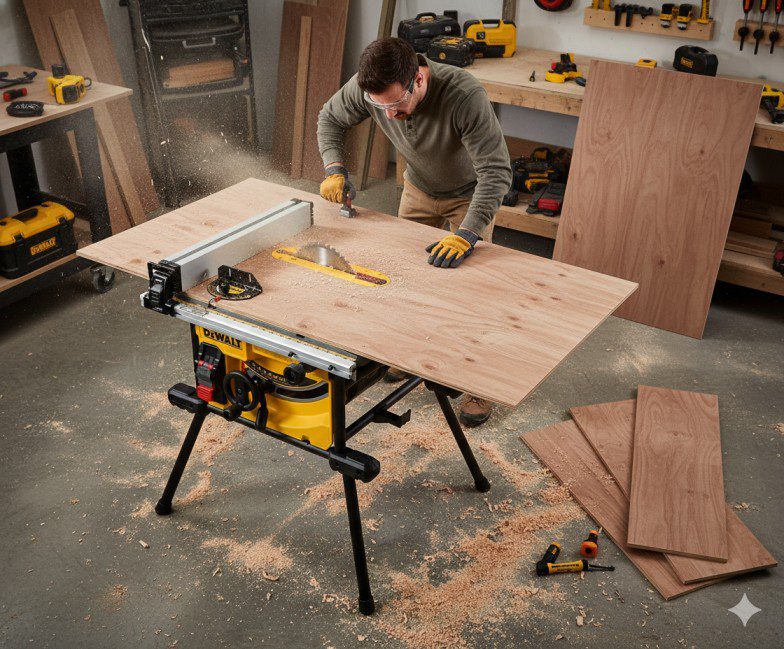
Scenario: Breaking down eight 4×8 sheets of 3/4″ plywood into 24″ strips
Battery: 6Ah FlexVolt (included with kit)
Results:
- Completed 5.5 sheets before battery exhaustion
- Motor maintained consistent RPM during full-length cuts
- Required slower feed rate than corded saw for clean cuts (blade heat buildup with aggressive feeding)
- Total runtime: Approximately 35 minutes of active cutting
Critical Observation: The 8-1/4″ blade struggles slightly more with plywood than dimensional lumber. Not a deal-breaker, but you’ll feel the difference compared to a 10″ corded saw with more blade speed and mass.
Test 3: Hardwood Ripping (Torture Test)
Scenario: Ripping 8/4 white oak into 2″ strips (4-foot lengths)
Battery: 9Ah FlexVolt
Results:
- Completed 28 linear feet of hardwood ripping
- Noticeable motor strain on knots and difficult grain
- Blade slowed approximately 10-15% during aggressive cuts
- Battery heat increased significantly
Verdict: The DCS7485 handles hardwood, but it’s working hard. This isn’t a hardwood mill saw—it’s a jobsite saw that can handle hardwood when necessary. For serious furniture-grade hardwood work, a corded contractor or cabinet saw remains the better choice.
Battery Runtime: The Numbers That Actually Matter

Marketing claims about “cuts per charge” are nearly useless because they never match real-world conditions. Here’s what I actually experienced:
Runtime by Battery Capacity
| Battery Size | Cutting Task | Approximate Runtime | Real-World Cuts |
|---|---|---|---|
| 6Ah FlexVolt | 2×4 crosscuts | 45-60 minutes | 120-150 cuts |
| 6Ah FlexVolt | 3/4″ plywood rips (8′) | 30-35 minutes | 40-50 linear feet |
| 9Ah FlexVolt | 2×10 rips (8′) | 60-75 minutes | 40-45 pieces |
| 9Ah FlexVolt | 8/4 hardwood rips (4′) | 25-30 minutes | 25-30 linear feet |
Critical Factor: 9Ah FlexVolt batteries run cooler and therefore last longer than 6Ah batteries under sustained load. This isn’t just about capacity—thermal management directly impacts runtime.
The Two-Battery Minimum Rule
Having only one battery significantly limits work capacity, so purchasing at least one extra battery is highly recommended. This isn’t optional advice—it’s mandatory for professional use.
Realistic Battery Strategy:
- Minimum Setup: Two 9Ah batteries ($358 for both)
- Comfortable Setup: Three 9Ah batteries ($537 total)
- All-Day Contractor Setup: Four batteries with dual-port charger (~$750)
Yes, battery costs add up quickly. A bare DCS7485 at $549 plus three 9Ah batteries totals $1,086—more than DeWalt’s flagship corded DWE7491RS with rolling stand ($599). This is the cordless premium you’re paying for convenience and portability.
Cut Quality and Power Delivery
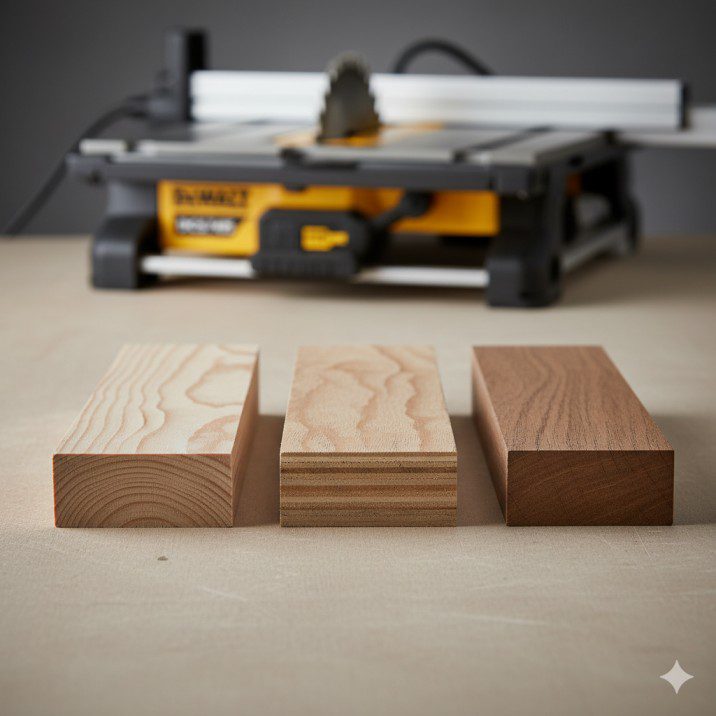
Cordless skeptics (myself included) worry that battery power means compromised cut quality. Here’s what six months of testing revealed:
Motor Performance
The brushless motor delivers 5,150 RPM power and speed to handle demanding cuts, spinning at 5,800 RPM under no-load conditions.
What This Means in Practice:
- Crosscutting dimensional lumber: Smooth, clean cuts comparable to corded saws
- Ripping softwood: Excellent performance with no visible burn marks
- Ripping hardwood: Adequate but requires proper blade selection and feed rate management
- Sheet goods: Very good results with sharp, thin-kerf blades
Honest Power Comparison: In side-by-side testing, power delivery seemed equal between the cordless DCS7485 and the corded DWE7485. I replicated this comparison and agree—for most jobsite tasks, you won’t notice a power difference.
Where You WILL Notice Differences:
- Long continuous cuts (10+ minutes without stopping)
- Dense hardwoods with challenging grain
- Dull blades (cordless shows power loss faster than corded)
Blade Considerations
The DCS7485 uses an 8-1/4″ blade with a 5/8″ arbor—standard sizing with one significant compromise.
8-1/4″ vs. 10″ Blade Trade-Offs:
Advantages:
- Lighter overall saw weight
- Lower battery consumption per cut
- Faster spin-up and stopping times
- Adequate for 90% of construction lumber
Disadvantages:
- Maximum cutting depth: 2-1/2″ at 90° (10″ saws cut 3-1/8″)
- Can’t cut through 4×4 posts in one pass
- Fewer blade options (10″ blades dominate the market)
- Less mass means easier bogging in dense material
Critical Limitation: The DCS7485 does not support dado blade stacks. If dado operations are part of your regular workflow, this saw isn’t for you. The Milwaukee 2736-21HD cordless table saw supports 3/4″ dado stacks—consider that alternative if dados matter.
Fence System and Accuracy
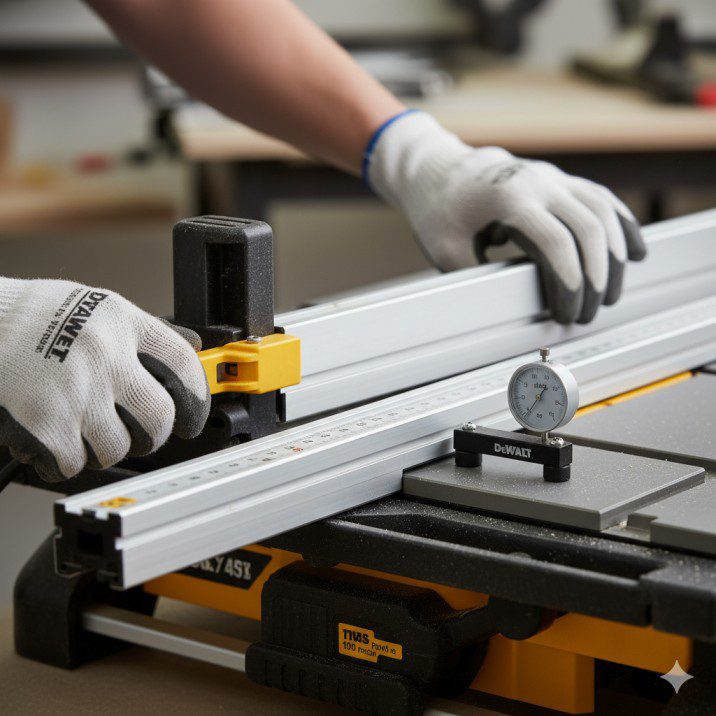
DeWalt’s rack-and-pinion fence system is the standout feature across their entire table saw lineup—and it’s excellent on the DCS7485.
Fence Design and Adjustability
Rack-and-pinion telescoping fence rails enable fast, smooth, and accurate adjustments with 24 inches of rip capacity for cutting 4×8 plywood or OSB sheets.
Real-World Fence Performance:
- Locks parallel to blade consistently (verified with dial indicator: ±0.003″ over 24″)
- Micro-adjustments are genuinely smooth (no stick-slip behavior)
- Fence face stays perpendicular under clamping pressure
- Quick-release lever requires minimal force
Comparison to Budget Saws: If you’ve used stamped steel fences that drift, flex, or require constant re-squaring, DeWalt’s rack-and-pinion system is a revelation. This alone justifies a significant portion of the price premium.
Setup and Calibration
Out-of-the-box blade-to-miter-slot alignment measured 0.007″ out over 10″—acceptable for jobsite work but not furniture-grade precision. Tuning took approximately 20 minutes using the trunnion adjustment bolts.
Post-Tuning Accuracy:
- Blade parallel to miter slot: 0.001″
- Fence parallel to blade: 0.002″
- Miter gauge slot tolerance: Loose (requires UHMW tape shimming for precision sleds)
For detailed guidance on setup, tuning, and calibration procedures, proper alignment dramatically impacts cut quality and safety.
Miter Gauge: The Weak Link
The miter gauge is constructed from plastic and lacks through-holes for attaching an auxiliary fence, unlike the metal gauge on the corded DWE7485.
Bottom Line: The included miter gauge is adequate for rough carpentry but unacceptable for precision crosscuts. Budget $75-100 for an Incra or Kreg aftermarket gauge if accuracy matters.
Portability Analysis: Weight vs. Convenience
Portability is the DCS7485’s primary selling point. But how portable is “portable” when you factor in batteries, chargers, and realistic job site needs?
True Weight and Carry Comfort

Official Weight: 48 pounds (saw only)
Real-World Carry Weight:
- Saw + 9Ah battery: 52 pounds
- Saw + battery + blade guard + fence in onboard storage: 55 pounds
- Add rolling stand (DW7451): 88 pounds total
One-Handed Carry: The integrated handle allows genuine one-handed carrying. This is a massive convenience advantage—try one-handing a DWE7491RS with rolling stand (110 pounds). Not happening.
Job Site Mobility Scenarios
Scenario 1: Upstairs Framing Carrying the DCS7485 up stairs is dramatically easier than corded alternatives. No extension cords, no generator noise, no power outlet hunting. This is where cordless shines brightest.
Scenario 2: Working Off Ladders/Scaffolding The metal roll cage base provides stable footing on scaffolding planks where heavier saws would be sketchy. The light weight means less structural load concern on temporary work platforms.
Scenario 3: Truck-to-Cut Distance If you’re setting up in one location for the day, cordless offers minimal advantage over corded (assuming power availability). You’re paying a premium for mobility you’re not using.
The Standless Question
The only compatible scissor stand is the DW7451, originally designed for 10-inch models. At $129, this adds significant cost. Alternatives include:
- Building a dedicated rolling cart (lumber + casters: ~$75)
- Using sawhorses with support wings (unstable for precision work)
- Mounting to job site workbench or truck bed platform
Most contractors end up buying the DW7451—factor this into your budget planning.
Comparing Cordless vs. Corded (DCS7485 vs. DWE7485)
DeWalt offers a corded version (DWE7485) with nearly identical features at $349—$200 less than the bare cordless version. Should you save the money and go corded?
Feature Comparison
| Feature | DCS7485 (Cordless) | DWE7485 (Corded) |
|---|---|---|
| Price (Bare Tool) | $549 | $349 |
| Power Source | 60V FlexVolt battery | 15-amp corded |
| Weight | 48 lbs | 45 lbs |
| Blade Size | 8-1/4″ | 8-1/4″ |
| Rip Capacity | 24″ | 24-1/2″ |
| RPM | 5,800 (no-load) | 5,800 (no-load) |
| Miter Slots | Single T-slot | Dual T-slots |
| Miter Gauge | Plastic | Metal with mounting holes |
| Power-Loss Reset | Yes | No |
| Runtime | Battery-dependent | Unlimited |
When Cordless Makes Sense
Choose DCS7485 if:
- You work across multiple floors/locations daily
- Power access is inconsistent or nonexistent
- You’re already invested in FlexVolt batteries
- You value setup speed over continuous runtime
- You work in noise-sensitive environments (cordless is quieter)
When Corded Makes More Sense
Choose DWE7485 if:
- Your saw stays in one workshop location
- You have reliable power access
- Budget is a primary concern
- You need unlimited runtime for production work
- The $200+ savings funds other tool purchases
For shop-based applications, corded is the more economical choice, while cordless excels when the saw is used in multiple locations.
What Works Exceptionally Well
After six months of professional use, these features genuinely impressed me:
1. Legitimate Corded-Equivalent Power
Skeptics claimed battery power couldn’t match corded performance. They were wrong. For 90% of jobsite cutting tasks, you won’t notice a power difference between the DCS7485 and corded alternatives.
2. Setup Speed
From truck to first cut in under two minutes. No cords to untangle, no outlet searching, no generator starting. This time savings compounds across a work day.
3. Fence System Excellence
The unique rack-and-pinion fence system secures both front and back, eliminating wobble and ensuring parallel movement that never goes out of alignment with the blade.
4. Safety Features That Actually Help
The Power-Loss Reset prevents accidental restarts when replacing batteries or after power disruptions, requiring deliberate switch activation. This has prevented several close calls when I forgot to turn off the saw before swapping batteries.
5. Onboard Storage
Everything has a place: blade guard clips onto the fence rail, riving knife stores in a dedicated slot, wrenches hang on integrated hooks, and the miter gauge slides into a storage channel. No more hunting for accessories.
6. Metal Roll Cage Durability
The metal roll cage base provides superior durability compared to plastic bases common on budget saws. After being knocked over twice and dropped from a truck tailgate once (don’t ask), the saw shows no structural damage.
The Frustrating Limitations
No tool is perfect. Here’s what genuinely frustrated me during testing:
1. Battery Costs Are Brutal
You need multiple batteries for professional use. A realistic three-battery setup costs $537 on top of the $549 bare tool price. Total investment: $1,086 before adding a stand. That’s SawStop territory.
2. No AC Adapter Option
Unlike DeWalt’s FlexVolt miter saw which offers an AC adapter, the table saw has no corded power option due to substantial costs for voltage conversion from 60V to 120V. When you’re in a workshop with power, you’re still burning battery capacity unnecessarily.
3. The Aluminum Table Trade-Off
Cast iron tables provide superior vibration dampening and thermal stability. The aluminum table on the DCS7485 is adequate but noticeably less refined than corded contractor saws with cast iron surfaces.
Practical Impact: Saw vibration is slightly higher during cuts, and the table surface shows scratches more easily. Not deal-breakers, but noticeable quality differences.
4. Power Switch Safety Paddle Annoyance
The red safety stop lever over the power switch can accidentally hit the stop button if released too quickly, turning off the saw seconds after starting. DeWalt allegedly addressed this in production units, but my saw occasionally exhibits this behavior.
5. Dust Collection Is Mediocre
The 2-1/2″ dust port captures maybe 40-50% of sawdust with a shop vacuum connected. Better than nothing, worse than quality cabinet saws. For outdoor work, this is irrelevant. For indoor cutting, expect significant cleanup.
6. No Dado Capability
The arbor design does not accommodate dado blade stacks. If you regularly cut dadoes, grooves, or rabbets on your table saw, this is a deal-breaker.
Who Should Buy This Saw
DEWALT 15 Amp 8-1/4 in. Compact Portable Jobsite Table Saw (DWE7485)
- 24.5 in. of rip capacity for ripping 4×8 plywood or OSB sheets
- Compact size for easy transportation and storage
- Rack & pinion telescoping fence rails make fence adjustments fast, smooth, and accurate
List Price :
Offer: 349.00
Go to AmazonThe DCS7485 isn’t for everyone. Here’s who benefits most from cordless table saw technology:
Ideal Buyers
The Multi-Location Contractor You’re framing additions, building decks, or doing remodeling where you’re constantly moving between job sites, floors, or locations without consistent power access. The DCS7485’s portability and setup speed pay for themselves in time savings.
The FlexVolt Ecosystem Builder You’ve already invested in DeWalt’s FlexVolt platform (miter saw, circular saw, grinder) and want battery interchangeability. Adding the table saw expands your cordless capability without buying into a second battery ecosystem.
The Tight-Access Specialist You work in attics, crawl spaces, or locations where running extension cords is difficult or dangerous. Cordless eliminates trip hazards and provides power where cords can’t reach.
The Noise-Conscious Professional You work in occupied homes, hospitals, schools, or noise-restricted areas. While not silent, the DCS7485 is noticeably quieter than corded saws—no motor whine from corded units or generator roar.
Better Alternatives For
The Workshop Woodworker If your saw lives in one location with reliable power, save $200-300 and buy the corded DWE7485 or invest in a proper contractor saw with cast iron table like the DWE7491RS.
The Hardwood Furniture Maker This is a jobsite saw optimized for construction materials. For sustained hardwood ripping and joinery precision, invest in a cabinet saw or hybrid saw with more mass and power.
The Budget-Conscious DIYer At $549 bare tool plus $180+ for a single 9Ah battery, the DCS7485 is expensive. Budget alternatives like the SKIL portable saw ($279) or corded DeWalt DWE7485 ($349) deliver better value for occasional users.
The Dado-Dependent Woodworker If dado operations are frequent in your workflow, the Milwaukee 2736-21HD supports dado stacks, or buy a corded saw with dado capability.
For comprehensive guidance on choosing the right table saw for your specific needs, consider how often you’ll actually use cordless functionality versus paying for convenience you don’t need.
Final Verdict: Is the DeWalt FlexVolt DCS7485 Worth It?
After six months of professional testing, here’s my honest assessment:
The DCS7485 is an exceptional cordless table saw that legitimately delivers corded-equivalent performance—IF you need cordless capability and can justify the premium cost.
The Math of Cordless Convenience
Scenario A: Multi-Location Contractor
- Time saved per day avoiding cord setup/breakdown: 15-20 minutes
- Hourly rate: $75/hour
- Monthly time savings value: $375-500
- Battery investment pays for itself in 3-4 months
Scenario B: Workshop Woodworker
- Time saved: Minimal (power is always available)
- Convenience value: Nice to have, not essential
- Battery investment payback: Never (you’re paying for unused capability)
My Recommendation
Buy the DCS7485 if:
- You’re a professional contractor working across multiple locations daily
- You’re already invested in FlexVolt batteries with 2-3 units already owned
- Setup speed and portability genuinely impact your productivity and income
- You can afford the premium ($549 + $180-360 in batteries)
Buy the corded DWE7485 or DWE7491RS instead if:
- Your saw primarily operates in one workshop location
- Budget constraints matter more than portability
- You need unlimited runtime for production work
- You want cast iron table quality and 10″ blade versatility
Skip table saws entirely and keep shopping if:
- You need dado blade capability
- You work primarily with hardwoods requiring sustained ripping power
- You’re a beginner uncertain about future needs (start with less expensive options)
The Bottom Line
The DeWalt FlexVolt DCS7485 represents the best cordless table saw technology available in 2025. It’s not perfect—battery costs sting, the aluminum table isn’t as refined as cast iron, and the lack of dado capability frustrates woodworkers. But for contractors who genuinely need portable power without compromising performance, this saw delivers on its promises.
I’m keeping mine in my truck for job site work while my corded DWE7491RS stays in the shop. That’s the real verdict: it’s good enough that I use it professionally every week, despite owning “better” stationary alternatives.
For additional accessories and upgrades that maximize your investment in any table saw, explore our table saw accessories guide.
Frequently Asked Questions
Q: How long does a FlexVolt battery actually last in real-world use?
Battery runtime varies dramatically by material and cutting intensity. Expect 40-45 eight-foot rips through 2×10 framing lumber with a 9Ah battery, or 25-30 linear feet of hardwood ripping. For crosscutting 2x4s, a 9Ah battery delivers 150-200 cuts. Always keep two batteries in rotation for professional use—one cutting, one charging.
Q: Can I use my DeWalt 20V MAX batteries in the DCS7485?
No. The DCS7485 requires 60V FlexVolt batteries specifically. However, FlexVolt batteries work in your 20V tools with extended runtime. This backwards compatibility makes FlexVolt batteries versatile but initially expensive investments.
Q: How does the DCS7485 compare to Milwaukee’s cordless table saw?
The Milwaukee 2736-21HD offers similar performance with one major advantage: it supports 3/4″ dado stacks, which the DeWalt does not. Milwaukee uses dual 18V batteries versus DeWalt’s single 60V battery. Performance is comparable, so choose based on your existing battery ecosystem and dado requirements.
Q: Is the 8-1/4″ blade size a significant limitation?
For most construction and jobsite work, no. The 2-1/2″ maximum cutting depth handles dimensional lumber through 2x10s, and 24″ rip capacity cuts plywood sheets. Limitations appear when cutting 4×4 posts (requires two passes) or finding specialty blades (fewer options than 10″ blades). Hardwood furniture makers will notice the smaller blade mass during sustained ripping.
Q: Do I really need the 9Ah batteries or will 6Ah work?
The 6Ah battery included with the kit works but depletes quickly under sustained use. For professional applications, 9Ah batteries are strongly recommended—they run cooler under load and provide 50% more runtime. Budget-conscious buyers can start with 6Ah and upgrade later, but you’ll feel the runtime limitations immediately.
Q: Can the DCS7485 replace my corded saw for full-time professional use?
Yes, with proper battery management. Many professionals use the DCS7485 as their primary jobsite saw by maintaining 3-4 batteries in rotation. The limitation is battery cost and charging infrastructure—you need a system to keep batteries charged on multi-day projects. For shop-based production work with unlimited power access, corded saws remain more practical.
Q: What’s the best blade for the DCS7485?
Use thin-kerf blades designed for 8-1/4″ saws to reduce battery drain and motor load. For general construction, a 40-tooth combination blade handles most tasks. For plywood, upgrade to a 60-tooth fine-finish blade. Avoid thick-kerf blades designed for 10″ saws—they’ll drain batteries faster and strain the motor unnecessarily.

Finlay Connolly is a woodworking enthusiast and power tool specialist with over a decade of hands-on experience in the workshop. As the founder and lead writer at ProTableSawReviews.com, Finlay combines expert knowledge with real-world testing to help woodworkers, DIYers, and professionals choose the best tools for the job. With a sharp eye for detail and a passion for precision, Finlay is committed to providing trustworthy, practical advice backed by years of experience and research in the field. Whether you’re cutting dados or comparing fence systems, you can count on Finlay for honest, reliable reviews that make your next cut your best one.

